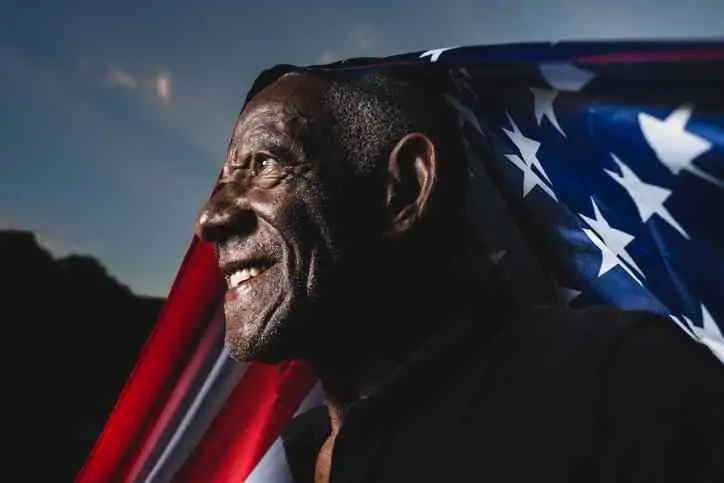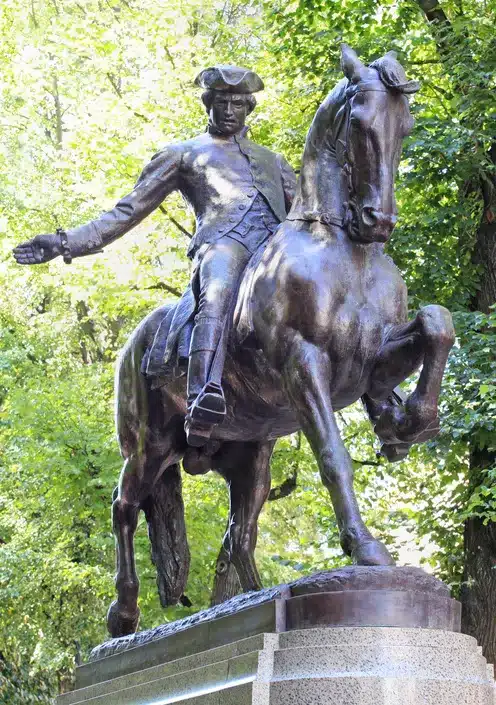The Battles of Lexington and Concord, fought on April 19, 1775, were the first military clashes of the American Revolutionary War. The Massachusetts militia routed the British Army forces and were soon joined by militias from Connecticut, New Hampshire, and Rhode Island.
PAUL REVERE’S RIDE, APRIL 18, 1775
In 1774 and 1775, the Boston Committee of Correspondence and the Massachusetts Committee of Safety hired Paul Revere as an express rider to carry news, messages, and copies of important documents as far away as New York and Philadelphia.
On the evening of April 18, 1775, Dr. Joseph Warren summoned Paul Revere and assigned him to ride to Lexington, Massachusetts, with the news that British soldiers stationed in Boston were about to march into the countryside northwest of the town.
The troops planned to arrest Samuel Adams and John Hancock, two leaders of the Sons of Liberty, who were at a house in Lexington.
That wasn’t accurate. The intelligence was faulty.
They were on a mission just the same.
Two If By Sea
Revere contacted an unidentified friend (probably Robert Newman, the sexton of Christ Church in Boston’s North End) and instructed him to hold two lit lanterns in the tower of Christ Church (now called the Old North Church) as a signal to fellow Sons of Liberty across the Charles River in case Revere was unable to leave town.
The two lanterns were a predetermined signal stating that the British troops planned to row “by sea” across the Charles River to Cambridge rather than march “by land” out of Boston Neck.
Revere then stopped by his own house to pick up his boots and overcoat and proceeded the short distance to Boston’s North End waterfront. Two friends rowed him across the river to Charlestown, past the British warship HMS Somerset in the darkness; Revere landed safely and informed Colonel Conant and other local Sons of Liberty about recent events in Boston. They had seen his signals in the North Church tower,
Revere borrowed a horse from John Larkin, a Charlestown merchant and a patriot sympathizer. While there, a member of the Committee of Safety named Richard Devens warned Revere that there were several British patrols in the area who might try to intercept him.

He Set Off at 11 p.m.
At about eleven o’clock, Revere set off on horseback. After narrowly avoiding capture just outside of Charlestown, Revere changed his planned route and rode through Medford, where he alarmed Isaac Hall, the captain of the local militia, informing him of the British movements. He then alarmed almost all the houses from Medford through Menotomy (today’s Arlington) — carefully avoiding the Royall Mansion whose property he rode through (Isaac Royall was a well-known Loyalist) — and arrived in Lexington sometime after midnight.
In Lexington, as he approached the house where Adams and Hancock were staying, Sergeant Monroe, acting as a guard outside the house, requested that he not make so much noise. “Noise!” cried Revere, “You’ll have noise enough before long. The regulars are coming out!”
The Three Riders
According to tradition, John Hancock, who was still awake, heard Revere’s voice and said, “Come in, Revere! We’re not afraid of you”. He entered the house and delivered his message.
About half past twelve, William Dawes, who had traveled the longer land route out of Boston Neck, arrived in Lexington carrying the same message as Revere. After both men “refreshed themselves” (i.e. had something to eat and drink), they decided to continue on to Concord, Massachusetts, to verify that the military stores were properly dispersed and hidden away.
A short distance outside of Lexington, they were overtaken by Dr. Samuel Prescott, who they determined was a fellow “high Son of Liberty.”
Paul Revere Walked Home
A short time later, a British patrol intercepted all three men. Prescott and Dawes escaped; Revere was held for some time, questioned, and let go. Before he was released, however, his horse was confiscated to replace the tired mount of a British sergeant. Left alone on the road, Revere returned to Lexington on foot in time to witness the latter part of the battle on Lexington Green.
This story comes from several accounts Paul Revere wrote after his Midnight Ride.
READ THE ACCOUNT IN HIS OWN WORDS ON THIS LINK





My forebearer was a Captain in General George Washington’s Continental Army when he was released in 1787. My family was Pennsylvania German and they had settled in Landcaster Co. in 1717 and had no loyalty to King George who thought he owned the whole place.
There is a whole “stuff” coming our way.
Be ready.
The day decent, hard working Christians finally got a butt-full of liberals.
“Stand your ground; don’t fire unless fired upon, but if they mean to have a war, let it begin here.”
~ Captain John Parker, Lexington MA, April 19 1775
Translation: Don’t start no shit, but if they fuck around, let them find out…
“Riders On The Storm”
Like a dog without a bone. An actor out on loan.
Killer on the road.
Who said it started today and what was it based on? I saw nothing.
We need to remind these folks who the boss is.